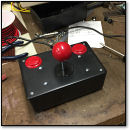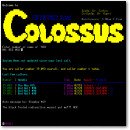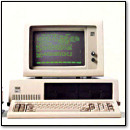[ Retro Scan of the Week ] Visual 1050 PC
March 3rd, 2014 by Benj Edwards “The complete professional solution at an unbeatable price.”
“The complete professional solution at an unbeatable price.”
I’ve never owned a Visual 1050 Personal Computer System (seen here), but I have an old Visual brand terminal that uses the same (or a very similar) keyboard. That’s the first thing that comes to mind when I see this, because it’s a distinctively wide, flat keyboard.
The 1050 sported a Z80 CPU and ran the CP/M operating system, the grandfather of MS-DOS. Curiously, even though CP/M was a popular platform for business computers in the late 1970s and early 1980s, I only have a a handful of pure CP/M-based machines in my collection. (My favorite such machine is probably the Kaypro II.)
In regard to the chart in the advertisement above, it’s interesting to note that it was pretty easy to undercut IBM, price-wise, not long after the IBM PC came out. Fast advances in IC design allowed computer makers to inexpensively cram more functions (think serial, parallel, game ports, disk controller, graphics card, etc.) directly onto motherboards instead of offloading them onto separate plug-in cards. While the 1050 was not an IBM PC clone, true PC clone makers took advantage of this effect to hollow out the inside of IBM’s hold on the PC market from the bottom up.
Discussion Topic of the Week: Do you have a favorite machine that runs CP/M?






March 4th, 2014 at 8:38 am
For me, of course, would be the Commodore 128 – The first comp I ever owned was a C=64. I had a C=128 in college and used it for several years after (until early 1994 it was still my primary computer) I still have a collection of Commodore machines (including an Educator 64) – I know that is somewhat off-topic. The C=128 came with a second proc that was a Z80. I admit, I rarely ever used CP/M – I had the boot disks and some basic software, but 90% of how I used my C=128 was in 40 col, C=64 mode for games and word processing. I had a nice spreadsheet program I used in 80 col, C=128 mode along with a few other tools for the C=128 mode. But all in all, I really used my C=128 as a C=64 and only booted up CP/M just to play around.
March 4th, 2014 at 11:26 pm
The Apple ][ (with a Microsoft Z80 SoftCard or one of its clones). If nothing else, for the ingenuity of putting a second chip on a card, which attests the popularity of CP/M – after all, the Apple ][ already had a decent library of software on its own. It was my first contact with the likes of MBASIC, WordStar, SuperCalc and dBASE II, paving the way to their ports and sucessors that would be the first entries on the MS-DOS landscape.
March 9th, 2014 at 12:59 am
Hey man, great work. I stumbled across a scan that you made of a Majora’s Mask ad earlier and I have been browsing for hours now. Keep up the fine work, the trip down nostalgia lane has been a blast.
March 13th, 2014 at 8:32 pm
I had one of these! Brings back some great memories – I used to think that the graph plotting in DR Graph was the best graphics that could ever possibly exist and that it would never get better! Oh how things change.
March 17th, 2014 at 8:55 am
I just love the part where the box says “two high capacity drives. 128k memory..” Dont want to know what will be considered high capacity in another 20 years.